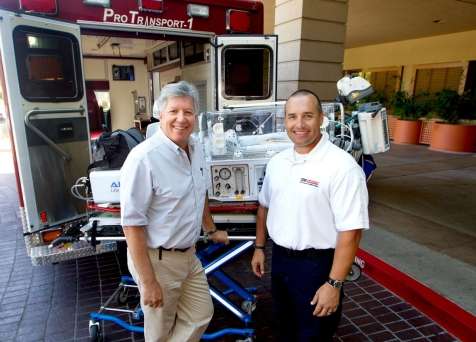New system aims to simplify patient transfers in emergency

In an emergency, hospitals need to be able to quickly and safely transport patients to other facilities, along with all the specialized equipment, such as ventilators and intravenous medications, that patients need. That can be a monumental task, particularly in the heat of a crisis.
"Before, in an emergency, nurses and doctors would have to commit a great deal of time to figuring out who needed what resources and what needed to be done," said Ronald Cohen, MD, clinical professor of neonatal and developmental medicine at the School of Medicine.
Lucile Packard Children's Hospital Stanford now has a new electronic medical records system that helps make this transfer process safer and more efficient in the event of a major crisis, such as an earthquake or power outage. Caregivers have prompt access to a fully automated report that categorizes patients in terms of their specific needs, such as what types of intravenous medication they receive, whether they're on ventilators or whether they need an intensive care unit bed.
It's all part of a Stanford-designed program called TRAIN (Triage by Resource Allocation for Inpatients).
Patient safety
TRAIN helps determine what vehicles and equipment are necessary for continuous patient care during a crisis event and simplifies communicating patients' needs to other hospitals or command centers coordinating transfers. For instance, TRAIN helps the hospital decide whether cars or vans are needed, how many ambulances or specialty transports are required and even how many IVs and ICU beds should be in place at the receiving facility.
"We can see exactly what resources are needed for each patient at all times. Should we have to evacuate, which we hope we never have to do, TRAIN puts us far ahead in terms of keeping our patients safe during an incident," said Brandon Bond, director of the Office of Emergency Management for the hospitals at Stanford.
We can see exactly what resources are needed for each patient at all times.
Under TRAIN, patients are assigned a color, with red designated for patients in critical condition. These patients need specialized transport, such as an ambulance or military vehicle, in addition to life-support equipment, such as ventilators and multiple intravenous drips for medication. TRAIN allows care teams to communicate the medical needs of this patient, as well as the severity of his or her condition, with a single word: red.
In comparison, patients marked with blue tags are considered stable and can be transported in a car or bus, without any specialized equipment.
Planning the process
TRAIN was first piloted in 2009 by Cohen, who tested it with premature infants in the neonatal intensive care unit. Cohen brought the idea to Bond, who saw the benefits of expanding the program to the entire hospital. The question then arose: Would doctors and nurses have to implement and update the color-coding system manually, or was there some way of automating it? How they answered that question was the real game-changer.
In the years that followed, Bond and Cohen worked with physicians and staff from departments throughout the children's hospital to develop a triage algorithm—a step-by-step procedure through which a computer automatically classifies patients according to TRAIN's simple color-coding matrix. With that process in place, the automated protocol could extend to include any patient at the hospital.
They assembled a team for the task, including Anna Lin, MD, clinical instructor of pediatrics; Kay Daniels, MD, clinical professor of obstetrics and gynecology; Stephanie Wintch, RN; and Kristine Taylor, RN.
Instant calculations
"Once we had the algorithm, we knew our electronic medical record could easily calculate the TRAIN classification," Cohen said. "Most importantly, the calculation could be done in an instant, without any additional work from doctors or nurses."
A new electronic medical records system called Epic, which was recently implemented throughout Stanford Children's Health, presented the perfect opportunity. A fully integrated health care software system, Epic allows physicians and nurses to record the condition of every patient, with constant updates in real time. Having that kind of information readily available during an emergency is invaluable to ensure patient safety, Bond said.
"The computer system automatically categorizes patients based on their needs, and that report is always on hand," Cohen said. "This would take hours to do manually, but it's now available instantly, 24 hours a day. It's an extremely valuable tool that hopefully we'll never need."











